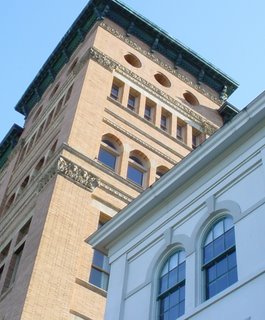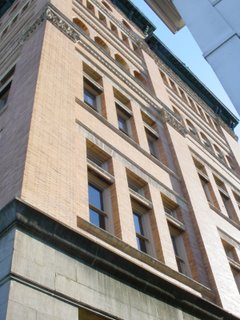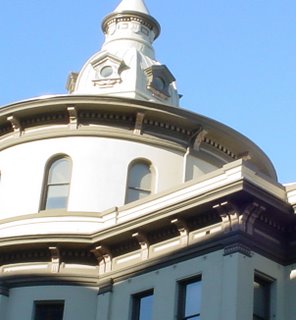 This is one of the Dragon Boat teams on the Thea Foss Waterway at the Asian American Water Festival. Bon Om Tuk is an event sponsored by the Cambodian American Support Network to promote understanding, diversity, and the sharing of resources.
This is one of the Dragon Boat teams on the Thea Foss Waterway at the Asian American Water Festival. Bon Om Tuk is an event sponsored by the Cambodian American Support Network to promote understanding, diversity, and the sharing of resources. Daisy, George and I attended the Festival on Saturday. While Daisy and I visited the food booths, watched the races, and enjoyed the music and crowds, George visited with friends at the Baha'i booth throughout the day. Although the Dragon Boat races occurring throughout the afternoon were certainly the most thrilling part of the celebration, Daisy and I enjoyed watching the introduction of rowing teams, with their banners and colorful t-shirts.
Daisy, George and I attended the Festival on Saturday. While Daisy and I visited the food booths, watched the races, and enjoyed the music and crowds, George visited with friends at the Baha'i booth throughout the day. Although the Dragon Boat races occurring throughout the afternoon were certainly the most thrilling part of the celebration, Daisy and I enjoyed watching the introduction of rowing teams, with their banners and colorful t-shirts.In Cambodia, this celebration also includes "Awk Ambok" (eating sticky rice with coconut juice and banana), "Sampeah Preah Khae" (worshiping the moon), and the "Bandaet Pratip Ceremony" (floating the lights). During this ceremony, Cambodians honor the Mekong river, which promotes fertile soil for crops. Similar ceremonies are held annually at the Chaktomuk River in front of the Royal Palace in Phnom Pehn.
 Bon Om Tuk has a long inter- woven history and connection with religious legends and Cambodian navy practices as part of military preparedness. Here, young men sit, watching the preparations.
Bon Om Tuk has a long inter- woven history and connection with religious legends and Cambodian navy practices as part of military preparedness. Here, young men sit, watching the preparations. Cambodian Dance Groups took the stage, singing songs and dancing. The predominant theme of the day was "Oneness".
Cambodian Dance Groups took the stage, singing songs and dancing. The predominant theme of the day was "Oneness". People layed out mats, brought their families, and played their musical instruments which included gongs, drums and free-reed mouth organs. The Chinese introduced 2-string fiddles and hammered dulcimers, and were influential in initiating the theatrical style of presentation. Some of these instruments and the music were banned during the war years, and is slowly being reintroduced. There is a distinction between 'music in Cambodia', and Cambodian music. The former embraces all ethnic groups within the national boundaries, and the latter is limited to the majority, Cambodians.
People layed out mats, brought their families, and played their musical instruments which included gongs, drums and free-reed mouth organs. The Chinese introduced 2-string fiddles and hammered dulcimers, and were influential in initiating the theatrical style of presentation. Some of these instruments and the music were banned during the war years, and is slowly being reintroduced. There is a distinction between 'music in Cambodia', and Cambodian music. The former embraces all ethnic groups within the national boundaries, and the latter is limited to the majority, Cambodians.  Buddhism was influential in the shaping of Asian festivals and music. The great temple city of Angkor, a place of pilgrimage, features murals with celestial dancers with harps, circular frame gongs, small cymbals, and suspended barrel drums. These elements evolved into the Pinn Peat Ensemble used for religious ceremonies, court dances, and theatrical plays.
Buddhism was influential in the shaping of Asian festivals and music. The great temple city of Angkor, a place of pilgrimage, features murals with celestial dancers with harps, circular frame gongs, small cymbals, and suspended barrel drums. These elements evolved into the Pinn Peat Ensemble used for religious ceremonies, court dances, and theatrical plays.Since George had to 'set up' early, Daisy and I drove down to the waterfront later in the day, and I had to park my car several city blocks from the event due to the crowds. I parked up on a hill in the middle of the historic part of Tacoma, the Stadium District. While we walked down the city streets, I thought what a different environment Tacoma is from the lovely lush fields and waterways of Cambodia. It takes a bit of stamina to adapt to cities. It is a whole different lifestyle.
 This is the bracketed clock tower at Old City Hall, built in 1893. It features pressed brickwork, terra-cotta ornamentation, and a copper tiled roof.
This is the bracketed clock tower at Old City Hall, built in 1893. It features pressed brickwork, terra-cotta ornamentation, and a copper tiled roof.  The brick walls at the base of the structure are eight feet thick and were made with bricks brought as ballast on ships. The clock tower is freestanding and its walls tilt inward as they rise, to increase the sense of height.
The brick walls at the base of the structure are eight feet thick and were made with bricks brought as ballast on ships. The clock tower is freestanding and its walls tilt inward as they rise, to increase the sense of height. Nearby, another richly decorated facade.
Nearby, another richly decorated facade. And, lastly, this is the facade of the old Elks Lodge, the BPOE. (Best People On Earth?) Someone had plastered a little 6 inch photo collage on the side of the building. There it was, looking like a tiny smudge on a corner. I walked over, bent down, and marveled that someone would take the time to create a statement about a dragon's appetite...."I'll turn you into oil."
And, lastly, this is the facade of the old Elks Lodge, the BPOE. (Best People On Earth?) Someone had plastered a little 6 inch photo collage on the side of the building. There it was, looking like a tiny smudge on a corner. I walked over, bent down, and marveled that someone would take the time to create a statement about a dragon's appetite...."I'll turn you into oil."
Well, that was the surprise ending to our day at the Dragon Boat Festival.